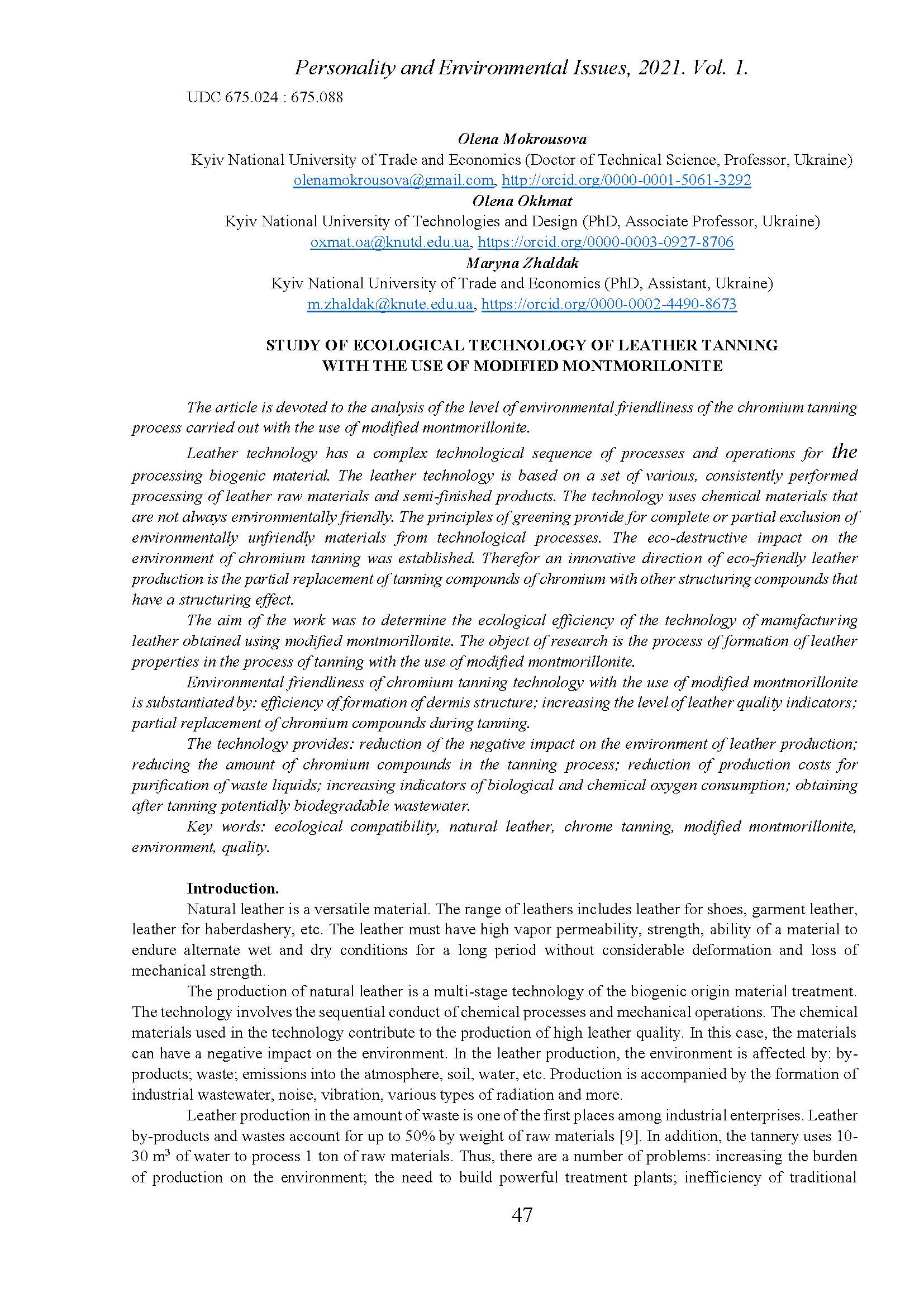Abstract
The article is devoted to the analysis of the level of environmental friendliness of the chromium tanning process carried out with the use of modified montmorillonite.
Leather technology has a complex technological sequence of processes and operations for the processing biogenic material. The leather technology is based on a set of various, consistently performed processing of leather raw materials and semi-finished products. The technology uses chemical materials that are not always environmentally friendly. The principles of greening provide for complete or partial exclusion of environmentally unfriendly materials from technological processes. The eco-destructive impact on the environment of chromium tanning was established. Therefor an innovative direction of eco-friendly leather production is the partial replacement of tanning compounds of chromium with other structuring compounds that have a structuring effect.
The aim of the work was to determine the ecological efficiency of the technology of manufacturing leather obtained using modified montmorillonite. The object of research is the process of formation of leather properties in the process of tanning with the use of modified montmorillonite.
Environmental friendliness of chromium tanning technology with the use of modified montmorillonite is substantiated by: efficiency of formation of dermis structure; increasing the level of leather quality indicators; partial replacement of chromium compounds during tanning.
The technology provides: reduction of the negative impact on the environment of leather production; reducing the amount of chromium compounds in the tanning process; reduction of production costs for purification of waste liquids; increasing indicators of biological and chemical oxygen consumption; obtaining after tanning potentially biodegradable wastewater.
References
Bandman, A. L. et al. (1989). Harmful chemicals Inorganic compounds of V-VIII groups: reference edition Lviv, Ukraine: Chemistry.
Bao, Yan, Ma, Jianzhong, Wangi, Yan-Li. (2009). Preparation of acrylic resin / montmorillonite nanocomposite for leather tanning agent, JALCA, 104(1), pp. 352–358.
Cavington, A. (1998). New tannages for the New Millenium, JALCA, 93(4), pp. 168–183
Danylkovych, A. H. et al. (2009). Technology and materials of leather production. Kyiv, Ukraine: Feniks.
Danylkovych, A. H. (2006) Workshop on chemistry and technology of leather and fur: a textbook. Kyiv, Ukraine: Feniks.
Ivashkevych, S. L. (1992). Treatment of industrial effluents of leather enterprises, Light industry, 2, pp. 37–39.
Hauber, C. (2000). Formation, prevention & determination of Cr(VI) in leather. [pdf]. Available at: https://leatherpanel.org/sites/default/files/publications-attachments/formation_prevention_and_determination_of_crvi_in_leather.pdf [Accessed 29 Oct. 2021].
Maistrenko, L., Andreyeva, O. (2011). Modern polymeric compounds for leather treatment: properties, effect on the collagen of derma. In: Abstracts Baltic Polymer Symposium-2011, Estonia, Tallinn 2011, P. 69.
Mokrousova, O., Andreyeva, O., Okhmat, O., Nikonova, A. (2018). Innovative approaches to increase the ecological compatibility of leather production, Visnyk KhNU, 5, pp. 51–55.
Moraru, V. N., Mokrousova, E. R. (2013). Electrosurface phenomena in the formation of leather structure: monograph. Lap Lambert Academic Publishing.
Pavlova, M. S. (1996). Basics of economic analysis of tannery, Leather and footwear industry, 6, pp. 20–25.
Senior, K. (2000). Chromium in the leather industry, World leather, 7, pp. 51–55.
Shalbuev, D. V. (2005). Comparative characteristics of wastewater generated during processing of leather and fur raw materials, Leather and footwear industry, 6, pp. 38–41.
Shalbuev, D. V., Slavhorodskaia, M. V. (2007). Fatty substances as the factor of anthropogenic influence of the leather and fur enterprises on an environment, Leather and footwear industry, 5, pp. 27–28.

This work is licensed under a Creative Commons Attribution 4.0 International License.
Copyright (c) 2022 Personality and Environmental Issues




